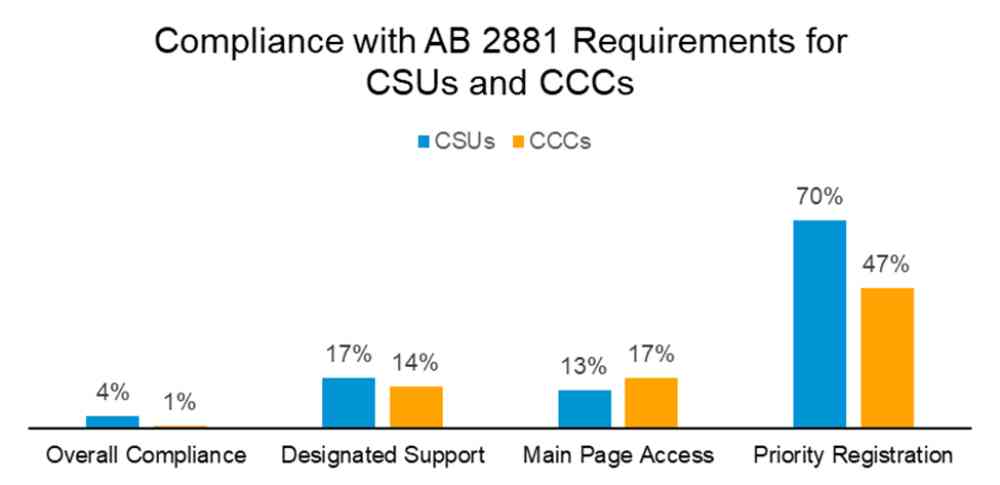Beyond Compliance: What California’s Student-Parent Data Reveal About Policy Implementation
California passed AB 2881 in 2022, promising student parents better access to resources and ensuring they would be eligible for priority registration across two of the state’s three public higher education systems: the California State University (CSU) system and California Community Colleges (CCCs). A few years later, how well are institutions actually delivering on these commitments?
Inspired by Dr. Tina Cheuk’s assessment methodology from September 2023, this evaluation examines AB 2881 implementation through a detailed rubric system. This study applies expanded evaluation criteria to capture implementation nuances across multiple institutional factors. The Greater Accessibility, Information, Notice, and Support for Student Parents Act (AB 2458, the GAINS Act) subsequently strengthened requirements for resource accessibility and data collection for the 2025 school year.
Are California’s Public Institutions Compliant?
My updated review, completed between July and September 2024, systematically examined all public institutions across California: 23 CSU campuses, 116 CCC campuses, and 10 University of California campuses (which were requested but not required to comply with AB 2881 and are not reported on below). For each institution, I evaluated whether its website adhered to explicit AB 2881 requirements:
- Student-parent resources are clearly visible and easily accessible from the main web page dropdown menu.
- Designated points of contact are present.
- Priority registration information is complete.
- Enrollment information is available for the required resources:
- CalFresh (California Supplemental Nutrition Assistance Program),
- the California Earned Income Tax Credit,
- the Young Child Tax Credit
- WIC (Special Supplemental Nutrition Program for Women, Infants, and Children).
To measure how difficult it was for student parents to find and use any information provided, I also rated the ease of each institution’s navigation on a scale from 0 (not navigable) to 2 (easily navigable).
Explore the California AB 2881 Webpage DatabaseWhat Is the Current Implementation Reality?
The findings show modest improvement, but significant gaps remain.
Overall Compliance:
- 4 percent of CSU colleges have fully implemented AB 2881 requirements
- 1 percent of CCCs have achieved full compliance
Designated Support:
- 17 percent of CSUs have a designated point person for student parents
- 14 percent of CCCs provide a clear contact for student-parent questions
Main Page Access:
- 13 percent of CSUs make student-parent resources accessible from their main webpage
- 17 percent of CCCs provide direct access to these critical resources
Priority Registration:
- 70 percent of CSUs meet all priority registration requirements
- 47 percent of CCCs have fully implemented priority registration support
Navigation Challenges:
- 13 percent of CSU student-parent resource pages were rated as not navigable, and 43 percent were difficult to navigate
- 41 percent of CCC student-parent resource pages were rated as not navigable, and 28 percent were difficult to navigate

Why Do Implementation Gaps Matter?
My findings are not just compliance statistics, they represent real barriers for student parents navigating higher education. When you’re juggling child care, coursework, and, often, employment, the mental load of navigating disconnected resources across multiple webpages can become overwhelming. Each additional click, each separate system to learn, each contact to find represents precious minutes student parents do not have. And that is just to identify available resources; the actual application for these resources is yet another barrier. The cumulative burden of this work can cause student parents to give up altogether.
For example, priority registration serves little purpose if students aren’t informed they’re eligible or must spend hours finding application procedures. And when student parents do not (or cannot) take up the supports offered to them, the supports do not serve their purpose of improving student outcomes.
This is why a centralized, one-stop resource page is essential. When institutions implement comprehensive, accessible web pages with clear points of contact, they acknowledge that for student parents with significant time constraints, simplified access to resources can mean the difference between persisting and stopping out.
Are Collaboration and Consistency on the Horizon?
AB 2881 implementation experiences across California’s public institutions can inform a collaborative support framework as colleges work to implement the GAINS Act. Developing a consistent approach will help ensure that support for student parents remains reliable regardless of which public higher education institution they attend.
My findings highlight the need for consistent terminology, accessible resources, and systematic data collection across all systems. The data showing only 4 percent of CSUs and 1 percent of CCCs in full compliance represent real barriers for thousands of student parents trying to navigate systems not designed with them in mind.
The path forward requires collaboration between policymakers and institutions, along with effective accountability measures, to ensure that legislation achieves its intended impact through consistent implementation. These findings offer critical guidance for other states working to develop not only strong policies but also effective implementation frameworks for student-parent support.
Passing legislation is just the first step toward meaningful change. Though implementation gaps persist across California's systems, the progress made and lessons learned can guide more effective support for student parents nationwide. And implementation is iterative—colleges’ responses to the updated requirements under the GAINS Act provide an opportunity to improve the quality of information they share online. This can enhance student parents’ knowledge as they pursue their education and career goals.